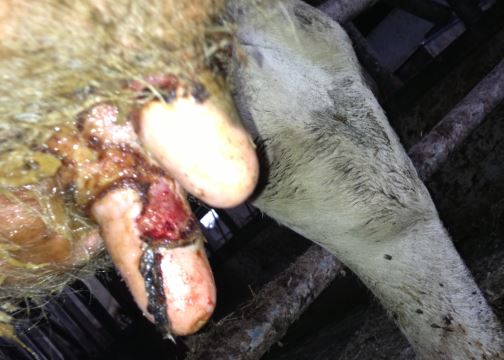



Help Needed to Solve Teat Removing Condition
UK - An English veterinarian is calling for help to unravel a mystery condition in dairy cattle that can result in cattle physically removing their own teats - in extreme cases all four teats.Ischaemic teat necrosis (ITN), first described in 2004, is a growing problem in cattle with no known treatment or cause.
In the early stages of the disease, intense irritation within the teat follows an early lesion, easily missed as an area of dry skin at the teat/udder junction. The problem, however, can quickly develop into something much worse, according to Gloucestershire-based cattle specialist, Roger Blowey.
Starting at the base of the teat, the currently unknown causal agent kills the teat tissue, which then becomes infected.

In some animals the whole teat becomes ‘intensely irritated’, causing profuse bleeding and leading to cows licking their teats to the point of removal in many cases.
Mr Blowey, who is keen to secure funding to advance understanding, has welcomed farmer input, whether in the form of anecdotal reports, farm surveys, or conversations at farmer meetings.
“I commonly bring up the subject at events and I often get questions and interest,” said Mr Blowey. “I have a form that people fill out to gain a basic epidemiology of the condition.”
Working with the Liverpool School of Veterinary Science, Mr Blowey has shown three digital dermatitis treponemes are present in samples sent in from round the country, although it is not known whether they are primary agents or secondary invaders.
These are the same treponemes responsible for toe necrosis and digital dermatitis, a growing issue in cattle lameness globally.
However, he still has not been able to tie down what role the treponemes play in the condition.
“We have been able to isolate the digital dermatitis treponemes from the majority of lesions, although we of course don’t know if they are primary or secondary,” said Mr Blowey.
He told TheDairySite that the key to the puzzle is assessing whether the treponemes are present at the interface between the healthy and diseased tissue.

“If they are, the digital dermatitis treponemes could contribute towards the pathogenesis,” he explained.
Part of their treponeme impact is to interrupt the skins’ healing process.
So far, common theories raised to explain the condition have extended to people questioning whether rubber liners on milking clusters should be replaced with silicone.
The cost to the industry is unknown but could be considerable. One farm has had to cull 20 per cent of heifers in each of the last two years due to the presence of ITN.
Reports of Ischaemic teat necrosis have come in from the Netherlands, although little has been reported much further afield, with no cases as yet in New Zealand.
ITN is present in Indian Buffalo herds, where published studies have described the condition. Anatomical differences mean Buffaloes are unable to lick their own teats.
Observations within the UK suggest the condition is more common in first calved heifers in early lactation. Aside from this, there is little known about trends regarding seasonality, breed, housing, or farm systems.
“What’s needed is a more concerted approach to do something about it,” urged Mr Blowey.
“A good database and survey would give an idea of what the condition is costing the industry.
“It requires more publicity, funding and someone with the right background to do something about it.”
Michael Priestley
News Team - Editor
Mainly production and market stories on ruminants sector. Works closely with sustainability consultants at FAI Farms



